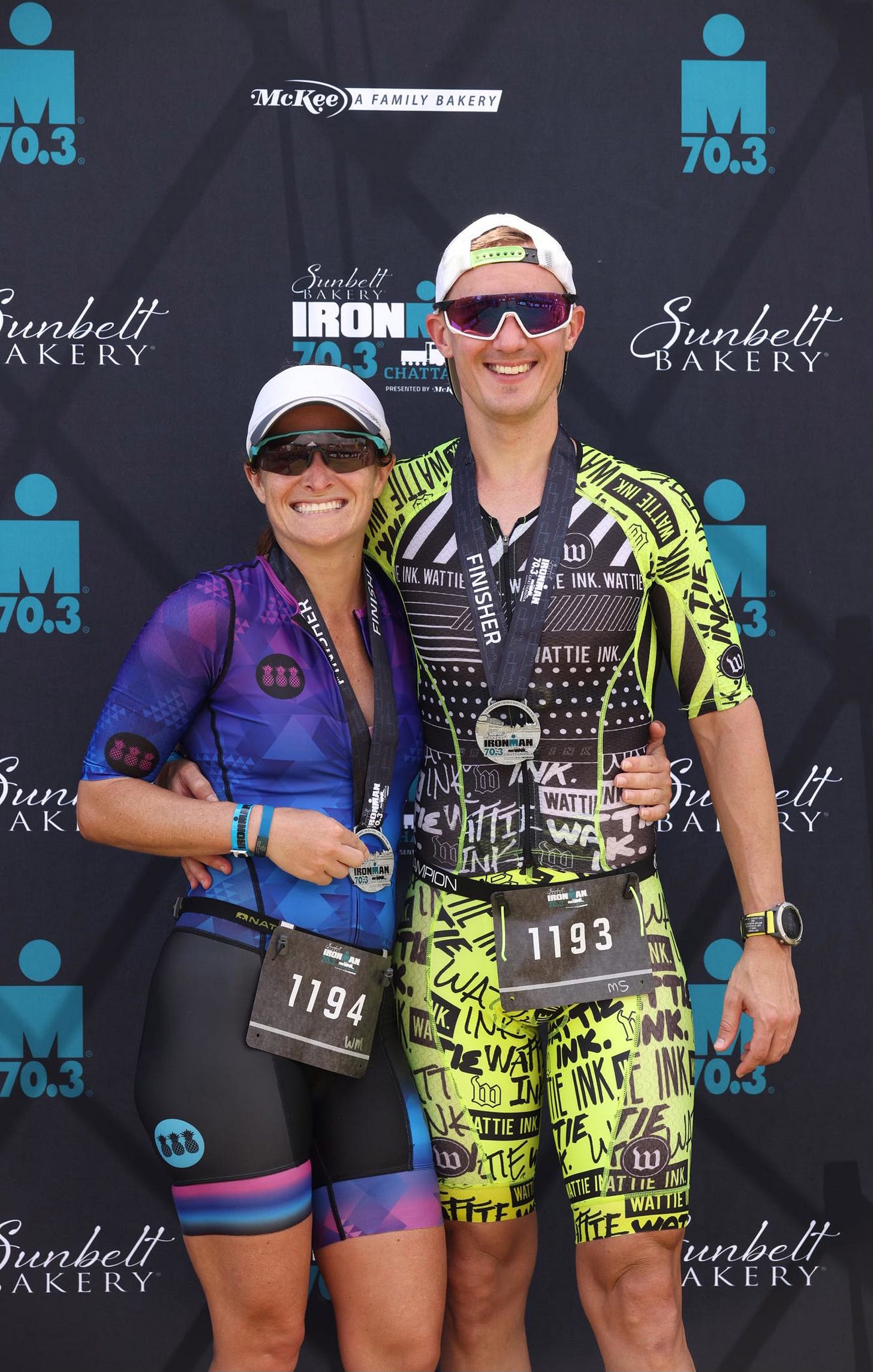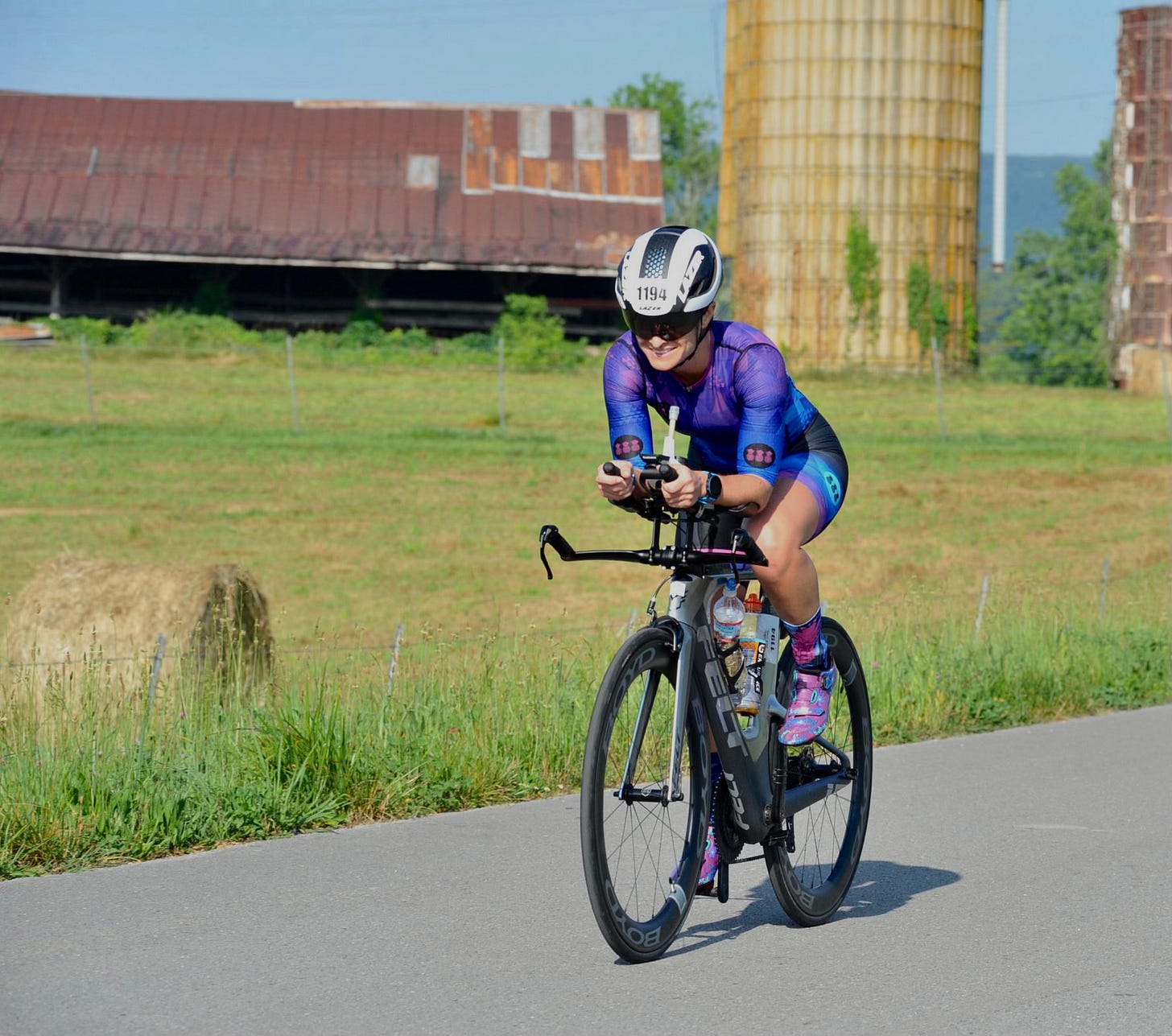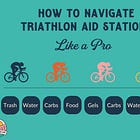Everything You Need to Know About 70.3 Chattanooga
Race preview with advice from 3 x 70.3 Chattanooga finishers
Triple Threat Life is an email newsletter with practical triathlon tips and mindset techniques to help everyday athletes succeed. Some installments are free. Some benefits are for paid subscribers only. Sign up here.
Congratulations! For those of you competing at 70.3 Chattanooga this weekend, you’ve officially made it to race week.
Although we’re not doing the race this year (see 70.3 Gulf Coast last weekend) Matt and I have competed in Chattanooga three times (2021, 2022, and 2023.) In 2021, it was our first 70.3, so this race holds a special place in our hearts.
Lately, I’ve had a lot of people asking questions about the course, the weather, and fun things to do in town, so rather than send a very long DM to everyone, I decided to write a course preview.
(This preview also works if you’re doing Ironman Chattanooga, because the course is very similar, with the exception of the new bike course for the full.)
70.3 Chattanooga falls on a Sunday, which gives you an extra day of travel for those who plan to drive. We live in Florida and it takes a full day to get to Tennessee, so we typically leave on a Thursday.
That puts us in town Thursday afternoon, and then we have Friday for a bike ride and swim and then athlete-check in. Then, on Saturday we do another bike ride and short run before bike check-in. I always like having a full 48 hours in town before a race, because it helps you get settled and into a regular routine before race day.
This is one of the largest Ironman 70.3 races in the US and sells out every year, so you should expect 3,000+ athletes. This means the line for athlete check-in will be long, so go early to avoid standing in the sun for hours. The expo and athlete check-in is at Ross Landing Park next to the Chattanooga Aquarium. There are a few parking garages in the area, but limited street parking.
TIP: Avoid getting caught up in all the pre-race hype. Do athlete check-in, buy a shirt at the expo, take a few photos, and get out. Being out in the sun on your feet half a day will not set you up well for a good race day experience. Also, the constant mental stimulation is draining. Save the fun for post-race.
Locations to Know
Ross Landing Park- site of the swim exit and transition
Veterans Bridge, Walnut Street Bridge, and Market Street Bridge- You will swim under the these bridges
You’ll ride by Lookout Mountain and through Chickamauga, a historic town with Civil War sites.
You’ll run across Veterans Bridge and Walnut Street Bridge- the blue pedestrian bridge. This is a great place for spectators to hang out.
The Riverwalk runs along the river.
Get More with the Triple Threat Life Club
Want deeper insights, expert advice, and exclusive perks? Join the Triple Threat Life Club for just $5/month and receive access to:
✅ FREE Tri Smarter, Not Harder Triathlon eBook- Releasing on Tuesday!
✅ Monthly expert video calls – Learn from pro triathletes, coaches, industry experts (Securing our speaker for May!)
✅ Exclusive discounts – Save $$$ on gear and nutrition from 13 top brands
✅ Bonus content & resources – Members-only articles, templates, and worksheets
✅ Support independent journalism – Help keep this newsletter going
Race Morning
We like staying in an AirBNB nearby so we can cook our own food, and it’s a short walk to transition on race morning. One time, we stayed further away (COVID) and had to park in a garage and walk to transition. Both methods are doable. Transition is very large, but there are good visual markers like parking ticket booths that you can use to reference your transition area.
At bike check-in, I always scope out transition. I walk the swim in, bike out, bike in, and run out. I also count bike racks so I know exactly where my transition area is located. There are numbers on the end of each bike rack as well.
We pump up our tires before racking our bikes in transition and typically don’t mess with them on race morning, unless there’s a big temperature change. If you want to pump up tires on race morning, I recommend bringing your own pumps because the pumps in transition never work very well and there’s a line to use them. You have to give your transition bag to a spectator anyways, because you can’t keep it in transition, so you can give them your bike pump too!
It’s about a mile walk from transition to the swim start, but there are shuttles that take you there. No need to add unnecessary miles to your legs before the race. Keep in mind that you want to get done in transition and on the bus as early as possible, because there are a lot of athletes. We’ve never had to wait long.
As far as weather is concerned, be prepared for a hot race, at least by the time you get to the run. That means cooling yourself on the bike by grabbing a water bottle at aid stations and dumping it on yourself. On the run course, pour water on your head, put ice in your trisuit, and hold ice in your hands.
Don’t be afraid to take walk breaks to re-set your form and lower your heart rate. This actually helps you run better, and faster overall. One year, a pro pushed it too hard in the heat and collapsed about a mile from the finish line. Don’t let that be you.
Success in Ironman isn’t about who goes the fastest, but who slows down the least.
The River Swim
You’ll probably hear people talk about the downriver current, and there can be, but that depends entirely on whether the dam opens the day before the race. You could have a very fast swim or not a lot of current at all, but every year we’ve raced it’s been wetsuit legal with water temperatures in the low 70s.
In the days leading up to the race, people tend to freak out about whether the swim will be wetsuit legal. This might sound like tough love, but if you’re trained to swim 1.2 miles, you’re trained to swim 1.2 miles. A wetsuit isn’t going to do it for you.
Can it help? Sure, it’s going to make you a bit faster and provide some buoyancy, but you still have to swim. You can’t do anything about the weather, so don’t stress about it. If you’ve been swimming consistently in the months leading up to the race, you’ll be fine. Don’t overthink it.
Because this is such a large race, it’s very important to seed yourself as early as reasonably possible. You have the opportunity to seed yourself in the swim line based on your expected pace.
If you’re swimming 2:00 per 100, you probably don’t want to line up with the 1:20 per 100 group, but be generous with your swim seeding. The faster swimmers are good at navigating, and it’s much more likely you’ll encounter problems with novice swimmers at the back of the pack.
This is important because you want to avoid traffic on the bike course and start the run before it gets too hot. Also, by the second lap of the run, the aid stations are packed and sometimes run out of ice.
Fun Fact: the swim course at 70.3 Chattanooga is actually 1.4 miles!
This is an amazing swim that travels in a straight line parallel to the shore. Maclellan Island will be on your right, and there’s a rocky cliff by the Hunter Museum of Modern Art on your left. It’s a nice, wide river, so it doesn’t get too crowded.
I like that the swim travels under four different bridges, because it helps you know how far you’ve gone. The buoys are all on your right. They’re yellow at the start and turn orange as you get closer to the finish. Those marking the swim exit will be red.
You exit the swim via a ladder, so let the volunteers help you up. There are wetsuit strippers if you want help getting out of your suit. There’s a steep metal ramp that takes you from the swim exit up to transition. I suggest walking this. You can jog, but it gets slippery and there’s no reason to spike your heart rate.
The Rolling Bike
This bike course is a lot of fun. It’s a rolling course, which means you can maintain a pretty good average speed for the ride. There’s just one “climb” at Andrews Ln. around the 27-mile mark, but it’s only 200 yards or so. Just use your smaller gears and it will be over before you know it.
One thing to keep in mind is that the start of the climb is a 90 degree turn to the left at the end of a downhill, so make sure you downshift upon approach.
In my opinion, the only tricky parts of this course are at the start: the bottle graveyard over the railroad tracks and the first few miles until you get into Georgia.
Although there will be a rubber mat over the railroad tracks, people take it way too fast. Slow down and keep a wary eye out for bottles. Also, the road surface isn’t great and there are some potholes, so pay attention for the first few miles.
Once you get on Hwy 193, the road conditions are excellent, and the ride is absolutely beautiful. Once you reach halfway point of the bike course, it’s a net downhill coming back to transition, so the second half of the ride is typically faster. Also, there’s a very fast downhill on the second half of the bike. You'll know when you get there.
Because this is a large race, be careful in aid stations. Know the flow: trash, water, hydration, gels, hydration, water, trash. (On this course, aid stations are at miles 11, 15, and 30.) If you need a bottle, use hand signals and let others know what you’re doing. People fly through the aid station going 20 mph and miss bottles that go rolling across the road. Look around and tell people where you’re going before making a move.
The Rolling Run

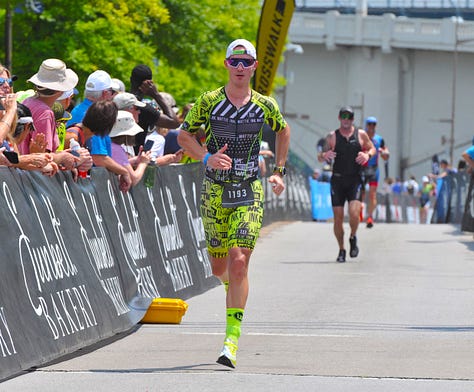
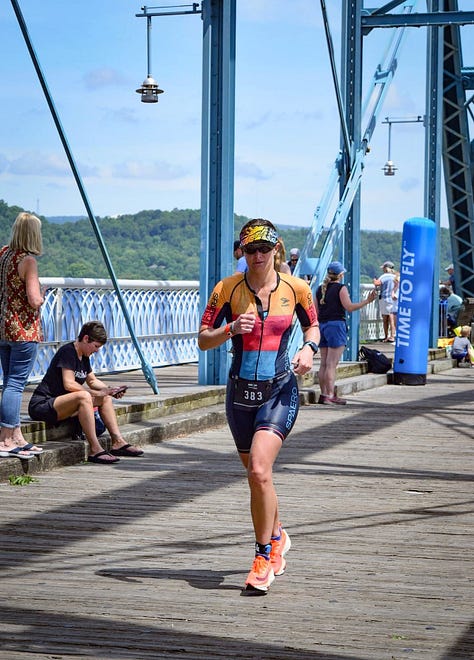
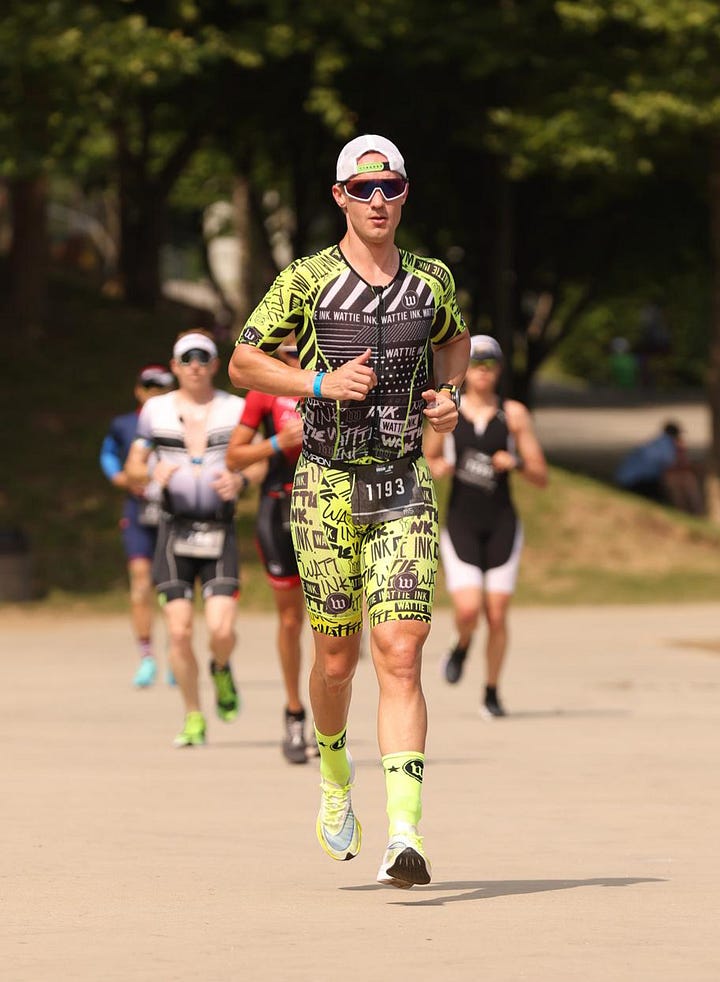
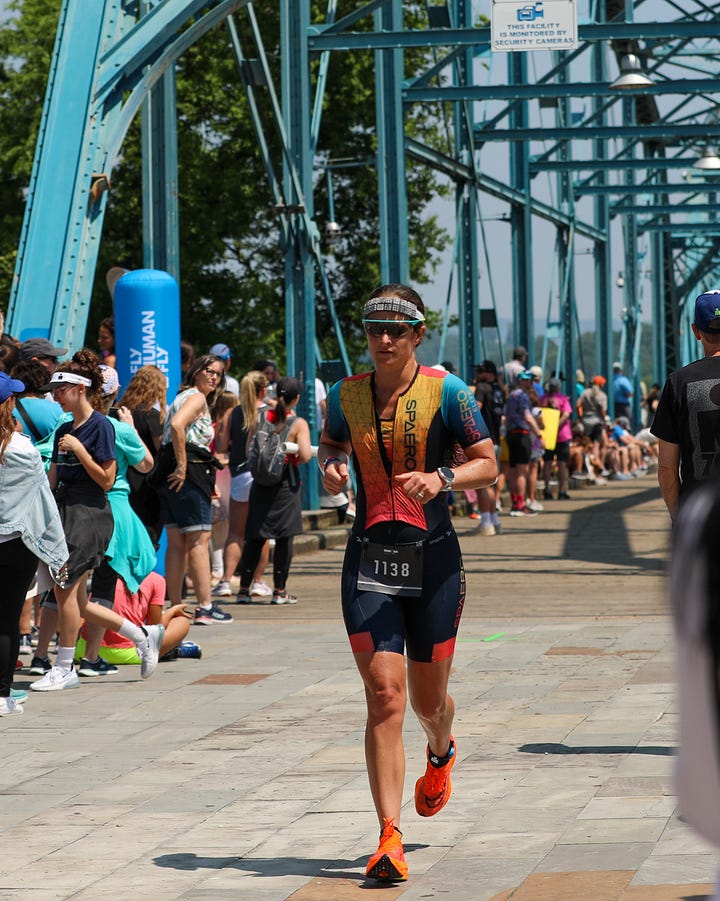
Although this run course has two laps with just 627 ft. of elevation gain, I would describe it as rolling, because there’s a few hills that can take their toll if you run them too hard.
There’s one surefire way to get into trouble on this run course, and it happens in the first half mile out of transition. There’s a long hill that takes you up past the Aquarium. Stop looking at your watch and run easy until you get up on run course proper.
I really enjoy this run course, because you can break it apart into sections. There’s a section along Riverfront Pwky with no shade that’s hot, a shaded portion on the Riverwalk, you go over Veterans Bridge (the flag bridge) to the other side of the river, and then back over the blue Walnut Street Bridge. Battery Hill is at mile 5. It’s pretty steep, but short, so many athletes walk up it because there’s an aid station at the top.
There’s a lot of run support on the pedestrian bridge, which is a great place for spectators to hang out. It’s a bit of a hill with some uneven footing but stunning views of the river. The best part of this course is getting to run back down that big hill to the finish line!
There are aid stations about every 1.5 miles on the run. Know the aid station flow and have a plan. There's also Porta Pottys in transition and at some aid stations. After the race, you’ll pick up your t-shirt, medal, and hat and take your finisher’s photo. Then, you can go into the food tent to get snacks and drinks. We had Jason Deli one year!
This is a great race to bring a tent and a few chairs, because it’s fun to hang out by the river after the race and cheer on fellow athletes.
Fun things to do in Chattanooga
A great pre-race activity is the Tennessee Aquarium and IMAX Theater, because it’s air conditioned and right next to transition. Get timed entry tickets, because they sell out. For kids, there’s the Chattanooga Zoo and Creative Discovery Museum. There’s also the Hunter Museum of Modern Art with outdoor sculptures and a great view of the river. You will swim and run by it on the course.
For a relaxing post-race activity, take a sunset walk across the Walnut Street Bridge and grab some ice cream. Also, we’ve taken a ride on the Southern Belle Riverboat, or you could do the WWII-era duck boat. Also, Lookout Mountain is a great spot to visit because it has Ruby Falls, Rock City, and the Incline Railway.





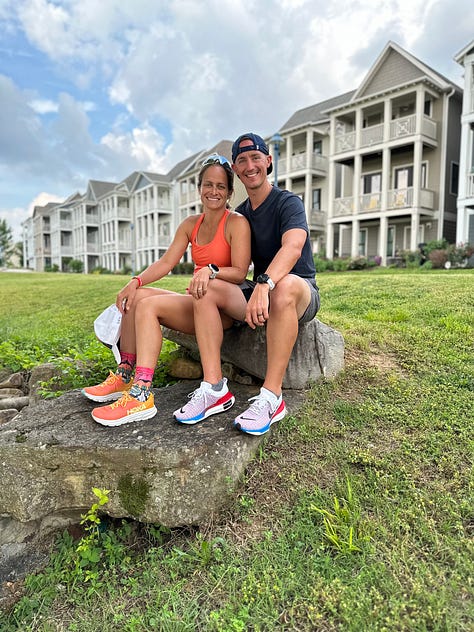
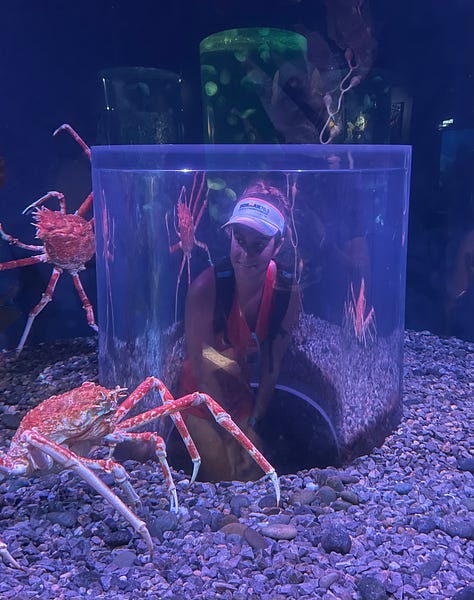
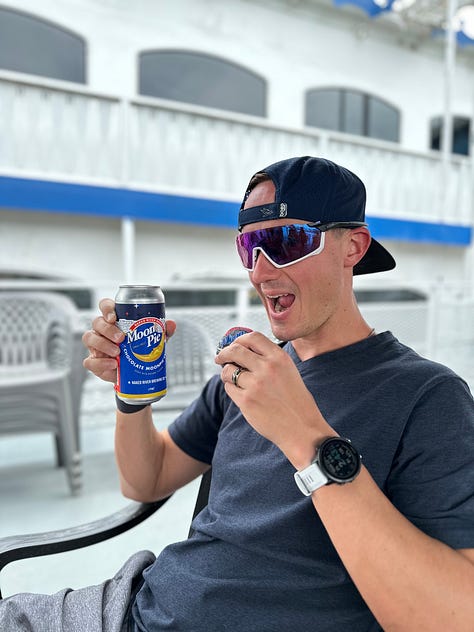
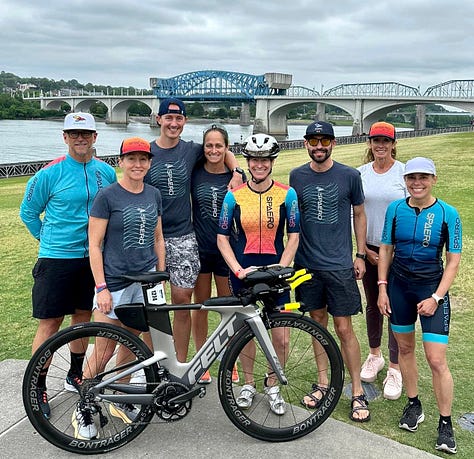
Ruby Falls is a 260 ft. underground waterfall located in Lookout Mountain. Rock City is just 6 miles from Chattanooga, and you can see seven states from the top. There are beautiful walking trails through gardens and caverns as well as a 100 ft. waterfall called Lovers Leap. The Incline Railway is 125 years old and within walking distance to Civil War sites. You can grab a bite to eat in St Elmo at the bottom.
TIP: My advice is to save these activities for after the race. The goal is to set yourself up for the best race possible, and that means doing race week workouts, eating nutritious meals, getting good sleep, and relaxing. You’re probably going to the race with family or friends, so don’t be shy about letting them know what you need in the days leading up to your big event. Plan something fun to do with them after the race.
Speaking of food, our favorite restaurants in Chattanooga include State of Confusion, Tupelo Honey, Maple Street Biscuit Company, and Scottie’s On the River. I wrote an article for IRONMAN about things to do in Chattanooga, so click here to check it out.
Please check the Athlete Guide to stay up to date with any changes to the course.
Good luck to our friends who will be racing 70.3 Chattanooga this weekend! Pros Grace and Katie, and age-groupers Jeremy, Emily, Noah, Sebastian, Signe, Michelle, Jeff, and probably a few more I forgot. Good luck everyone!
Also, a special good luck to my coach, Marni, who’s competing at IRONMAN Lanzarote this weekend!
News & Notes:
Exciting news! The Tri Smarter, Not Harder: 50 Essential Tips For Every Triathlete e-book is finished and will be released on Tuesday. Remember, paid subscribers get the e-book for free, so upgrade your subscription today. If you don’t have a $5 a month paid subscription, you can purchase it separately.
2. My latest published work:
A. Veteran Athletes Give Their Best Advice For Your First IRONMAN- I decided I wanted to include advice from both pro athletes and age-groupers, so we’ve got:
AG- My friends Catherine Demet, Tara Manson Calkins, Claire Glass, Angela Gajda, Eric Keil. Pros- Alice Alberts, Matt Jackson, Laura Phillip, and Emma Pallant Browne. In total, these athletes have completed over 58 full IRONMAN and 89 70.3 races!
B. Which Type of Bike Should I Use for an IRONMAN Triathlon?- This is one of the most frequently asked questions among first-time IRONMAN athletes. Should you use a road bike or a triathlon bike? The answer is: it depends.
C. Endurance Nutrition Basics 101: How to Fuel for a 70.3- A simple breakdown of how to fuel for a 70.3 triathlon with Marni Sumbal, Board Certified Sports Dietician and owner of Trimarni Coaching and Nutrition.







